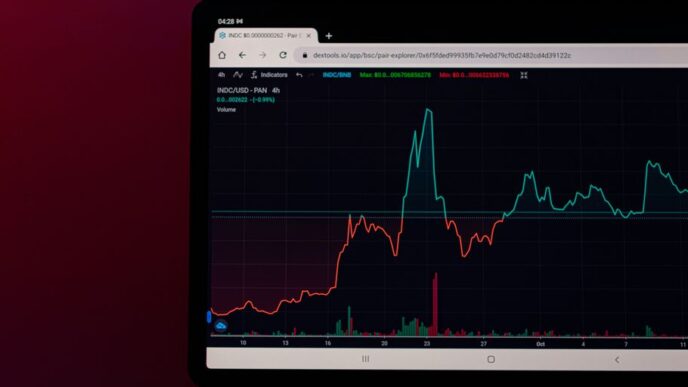So, you’re looking to get into crypto data? It can feel a bit overwhelming, right? There’s just so much information out there. But don’t worry, the CoinGecko API is a pretty solid way to get started. It helps you grab all sorts of crypto insights without too much hassle. This guide will walk you through how it works, what you can do with it, and even how to build something cool of your own. We’ll also touch on some other options if you need them. Basically, with CoinGecko, you can really open up a bunch of new possibilities for your crypto projects.
Key Takeaways
- The CoinGecko API offers a huge amount of crypto data, making it a good choice for anyone needing market information.
- It’s pretty easy to get the CoinGecko API working with your own projects, no matter what programming language you’re using.
- You can access different levels of the CoinGecko API depending on what you need, from simple data pulls to more advanced features.
- Even though there’s no official OpenAPI spec, the community has made resources that help you understand and use the CoinGecko API.
- Using the CoinGecko API lets you build things like crypto dashboards and other tools to help you understand the market better.
CoinGecko Overview and Significance
CoinGecko is more than just another crypto data provider; it’s a solid platform delivering real-time market insights. From small developers to big companies, CoinGecko has become a go-to resource. It started with the goal to democratize access to crypto data, offering a wide range of features like detailed exchange info, transparent pricing, and a huge library of assets.
Why CoinGecko APIs?
So, why pick CoinGecko’s APIs over others? Here’s the lowdown:
- Reliability: CoinGecko has earned a strong reputation in the industry, thanks to its extensive cryptocurrency coverage, real-time market data, and transparent pricing.
- Comprehensive Data: As the world’s largest independent crypto data aggregator, CoinGecko is a pretty comprehensive data source. You can easily access and track data on price, volume, and market capitalization of over 12,000 cryptocurrencies and more than 900 exchanges.
- Easy Integration: CoinGecko APIs let developers and analysts integrate cryptocurrency and blockchain data into their projects. You can easily access the most comprehensive and reliable data through RESTFUL JSON endpoints.
Access to a Comprehensive Data
As the world’s largest independent crypto data aggregator, CoinGecko is the most comprehensive data source out there. With CoinGecko API, you can easily access and track data on price, volume, and market capitalization of over 12,000 cryptocurrencies and more than 900 exchanges (CEXes and DEXes).
Easy Integration
CoinGecko APIs let developers and analysts integrate cryptocurrency and blockchain data into their projects. With CoinGecko APIs, you can easily access the most comprehensive and reliable data through RESTFUL JSON endpoints.
Revealing CoinGecko API’s Capabilities
So, you’re thinking about using the CoinGecko API? Good choice! It’s a pretty powerful tool, and it can do a lot more than just spit out some numbers. Let’s break down what it can really do for you.
CoinGecko API Tiers and Access Strategies
CoinGecko doesn’t just have one API; it has different levels, or tiers, depending on what you need. This is great because you don’t have to pay for features you won’t use. They have various API access tiers, so you can scale your usage as your project grows. It’s designed for everyone from hobbyists to big companies.
CoinGecko Key Functionality Highlights
The CoinGecko API is more than just a data source; it’s a platform. Here’s a quick rundown of some key things it can do:
- Real-Time Data: Get up-to-the-minute info on crypto prices, volume, and market caps.
- Historical Data: Dig into the past to see how coins have performed over time.
- Exchange Data: Track what’s happening on different crypto exchanges.
Cryptocurrency Data Retrieval
CoinGecko’s API makes it easy to get the exact data you need. Here’s how:
- Comprehensive Data: Access data on over 12,000 cryptocurrencies and 900 exchanges. CoinGecko is the world’s largest independent crypto data aggregator.
- Rate Limiting: They use rate limits to keep things running smoothly for everyone. This prevents abuse and ensures fair access.
- Customization: You can customize your requests to get only the data you need, filtering and sorting based on different criteria.
Harnessing the Power of CoinGecko Data
Practical Implementation Strategies
With CoinGecko’s extensive data, you can create powerful applications. The possibilities are pretty broad, from portfolio trackers to advanced trading bots. Here are a few ways to use CoinGecko’s data:
- Building Portfolio Trackers: Keep tabs on your crypto holdings in real-time. This is super useful for seeing how your investments are doing at a glance.
- Creating Trading Bots: Automate your trades based on market data. You can set up bots to buy or sell based on price movements or other indicators.
- Developing Market Analysis Tools: Spot trends and make better investment decisions. Practical guides can help you understand market dynamics.
Building a Simple Crypto Analytical Dashboard
Let’s be real, everyone loves a good dashboard. Here’s how to make one using CoinGecko data:
- Data Retrieval: Use the CoinGecko API to grab the data you need. This includes prices, volume, and market cap.
- Data Processing: Clean and format the data. You might need to convert currencies or calculate moving averages.
- Visualization: Display the data in charts and graphs. Libraries like Chart.js or Python’s Matplotlib can help.
Here’s a simple table example:
| Cryptocurrency | Price (USD) | Volume (24h) |
|---|---|---|
| Bitcoin | $30,000 | $20 Billion |
| Ethereum | $2,000 | $10 Billion |
| Litecoin | $100 | $1 Billion |
Maximizing Data Utility
To really get the most out of CoinGecko’s data, consider these points:
- Historical Data Analysis: Look at past trends to predict future movements. This can be really helpful for long-term investing.
- Real-Time Monitoring: Keep an eye on the market as it changes. This is crucial for day traders and anyone who needs to react quickly.
- Combining Data Sources: Mix CoinGecko data with other sources for a more complete picture. Think news feeds, social media sentiment, and on-chain metrics.
CoinGecko OpenAPI/Swagger Specification

While CoinGecko doesn’t officially provide a Swagger or OpenAPI specification, the community has created some resources to help developers use its API. These community-driven repositories give developers access to detailed endpoint descriptions, request examples, and response formats, making it easier to integrate CoinGecko data into applications. These unofficial specifications are a great resource for a structured approach, providing the details needed for making requests and understanding responses from CoinGecko’s endpoints.
Community-Driven Resources
Even though CoinGecko doesn’t have an official OpenAPI/Swagger specification, the community has stepped up. You can find various community-driven repositories that offer detailed information. These resources typically include:
- Endpoint documentation: Clear descriptions of each endpoint’s purpose and functionality.
- Request examples: Sample requests to help you understand how to structure your API calls.
- Response formats: Examples of the data you can expect to receive from the API.
These resources can really speed up the development process, especially when you’re trying to figure out how to use a specific endpoint.
Structured Approach to API Interaction
For developers who like a structured approach, these unofficial specifications are super useful. They provide the details needed to make requests and understand the responses from CoinGecko’s endpoints. This is especially helpful when you’re dealing with complex APIs that have a lot of different endpoints and data structures. Using a specification can help you avoid common mistakes and ensure that your code is working correctly. You can even use tools to automatically generate client code from the specification, which can save you a lot of time and effort. Check out this CoinGecko API for MCP.
Interpreting CoinGecko Endpoints
Understanding how to interpret CoinGecko endpoints is key to getting the most out of the API. Here’s a quick rundown of what you might encounter:
/coins/{id}: This endpoint lets you get data for a specific coin, using its ID./coins/{id}/market_chart: Use this to access market data within specific time ranges./exchanges: This lists all available exchanges and their info.
Knowing what each endpoint does helps you pull the right data for your project. For example, if you’re building a trading bot, you’ll probably use the /coins/{id}/market_chart endpoint to get historical price data. If you’re building a portfolio tracker, you might use the /coins/{id} endpoint to get the current price of each coin in your portfolio.
Maximizing the Power of Cryptocurrency Data with CoinGecko
The CoinGecko API is more than just a way to grab some numbers; it’s a launchpad for all sorts of cool stuff you can do with crypto data. Whether you’re dreaming up a trading platform, a slick financial gadget, or even diving into the NFT craze, CoinGecko gives you the data backbone to make it happen. The CoinGecko API is officially documented and pretty solid, but its real potential goes way beyond just pulling data.
Advanced API Management
Think of your API as a finely tuned engine. To keep it running smoothly, you need to manage it well. That’s where things like authentication, rate limiting, and analytics come into play. Here’s a few things to consider:
- API Gateways: Tools like Zuplo can handle the heavy lifting of API management, taking care of authentication and keeping things secure.
- Rate Limiting: Don’t let anyone hog all the resources. Set limits to ensure fair access for everyone.
- Error Handling: Plan for things to go wrong. Implement robust error handling to gracefully deal with issues.
Performance Monitoring and Caching
Speed matters, especially in the fast-paced crypto world. You want your apps to be snappy and responsive. Here’s how to make that happen:
- Monitoring Tools: Keep an eye on API usage and performance with tools like Datadog or New Relic. Spot bottlenecks before they become problems.
- Caching: Store frequently accessed data using something like Redis or Memcached. This way, you’re not constantly hitting the API for the same info.
- Optimize Queries: Make sure your data requests are efficient. Only ask for what you need, and structure your queries wisely.
Unlocking New Opportunities
CoinGecko’s data opens doors to all sorts of possibilities. Here are a few ideas to get your creative juices flowing:
- Algorithmic Trading: Build bots that automatically trade based on market data. Just be careful – it’s a wild world out there.
- Portfolio Trackers: Help people keep tabs on their crypto holdings. Everyone wants to know how their investments are doing.
- Market Analysis Tools: Give users insights into market trends and potential opportunities. Knowledge is power, after all.
With a little creativity and some solid coding skills, you can turn CoinGecko’s data into something truly amazing. The world of cryptocurrency data is your oyster!
Transforming Data Into Insight With CoinGecko APIs
So, you’ve got all this cryptocurrency data from the CoinGecko API. Now what? It’s time to turn that raw information into something useful. This section is all about taking that data and making it work for you. We’ll walk through some practical examples and show you how to build something cool. Let’s get started!
Understanding Crypto API Benefits
Why even bother with a crypto API? Well, for starters, it gives you direct access to a ton of data without having to scrape websites or rely on potentially unreliable sources. The main benefit is having real-time, accurate data at your fingertips. Think about it: you can track price movements, trading volumes, and market caps for thousands of cryptocurrencies. This is super useful for making informed decisions, whether you’re a trader, investor, or just curious about the market. Plus, APIs let you automate a lot of tasks, like pulling data into spreadsheets or building custom dashboards. This saves you time and effort in the long run. You can also use the data to build your own crypto analytical dashboard.
Live Demo Integration
Okay, let’s get our hands dirty. We’re going to walk through a simple example of integrating the CoinGecko API into a basic application. We’ll use Python because it’s easy to read and has a bunch of libraries that make working with APIs a breeze. We’ll start by fetching the current price of Bitcoin and displaying it on the screen. Then, we’ll add some more features, like displaying the 24-hour price change and the market cap. The goal here is to show you how easy it is to get started with the API and how you can use it to build something useful. We’ll cover:
- Setting up your Python environment
- Making API requests to CoinGecko
- Parsing the JSON response
- Displaying the data in a user-friendly format
Building an Analytical Dashboard
Now, let’s take things a step further and build a simple analytical dashboard. This dashboard will display key metrics for a few different cryptocurrencies, like Bitcoin, Ethereum, and Litecoin. We’ll use a library like matplotlib or seaborn to create some charts and graphs that visualize the data. The idea here is to give you a starting point for building your own custom dashboard that tracks the metrics that are most important to you. Here’s what our dashboard might include:
- Price charts showing the historical price movements of each cryptocurrency
- Bar charts showing the trading volume for each cryptocurrency
- A table displaying key metrics like market cap, 24-hour price change, and circulating supply
- The ability to select different time periods for the charts and graphs
With this dashboard, you can easily monitor world coin values and make informed decisions about your investments.
Conclusion
So, we’ve gone through a lot about the CoinGecko API, right? It’s pretty clear that this tool is a big deal for anyone messing around with crypto data. It helps bridge the gap between all that complex blockchain stuff and what regular folks, or even businesses, need to see and use. Before these kinds of APIs came along, getting good, reliable crypto info was a real headache. Now, it’s way easier to get insights, make smart choices, and even build cool new things in the crypto world. It’s definitely made the whole industry a lot more open and useful for everyone.
Frequently Asked Questions
What is CoinGecko?
CoinGecko is a major platform that gathers and shows information about cryptocurrencies. It’s like a big library for crypto data, helping people understand the market better.
What is the CoinGecko API?
The CoinGecko API lets computer programs get crypto data directly from CoinGecko. This means developers can build apps that use real-time prices, market trends, and other important crypto information.
What can I build with the CoinGecko API?
Developers use the CoinGecko API to create many different things, like apps that track their crypto investments, tools that show live prices, or even programs that analyze how the crypto market is doing.
Is the CoinGecko API free to use?
Yes, CoinGecko offers different levels of access to its API. Some levels are free for basic use, while others require payment for more data or faster access, depending on what you need.
What kind of data can I get from the CoinGecko API?
The CoinGecko API gives you lots of data, including current prices of cryptocurrencies, how much they’ve been traded, their market value, and even historical data to see how prices have changed over time.
Are there any guides or specifications for using the CoinGecko API?
While CoinGecko doesn’t have an official Swagger or OpenAPI guide, the community has made helpful unofficial guides. These guides show you how to use the API and understand its different parts.














